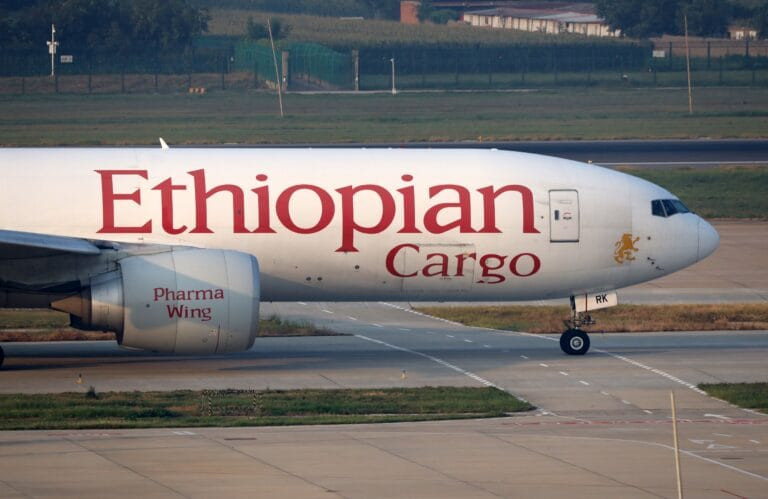Airfreight plays a crucial role in facilitating trade between African countries and the rest of the world by enabling quick and efficient transport of high-value and perishable goods Over the past decade, Africa’s airfreight market has experienced significant growth, driven by economic expansion, technological advancements, and evolving consumer behaviours. Air cargo volumes nearly doubled, rising from 2.2 million to 4.2 million tonnes per kilometer. This growth highlights the increasing role of air transport in supporting trade and economic development across the continent.
“As African airfreight carriers showed major improvements in technology, knowledge, and capacity to meet the growing air cargo demand, the market has evolved immensely,” a spokesperson for Ethiopian Airlines stated.
“Challenges in the past decade have also brought an opportunity. The Covid-19 pandemic has left an unforgettable impact on training cargo carriers in how to survive.”
“Changing consumer awareness has contributed to increased demand for perishable goods, reinforcing the need for efficient air transport,” Racheal Ndegwa, CEO Swissport Kenya, added. “Innovative solutions such as the flower corridor by Swissport in Kenya and now being extended to Liège and other European stations have been developed with the consumer in mind. As cargo volumes continue to rise, air freight is becoming an even more critical enabler of Africa’s landscape.”
Trade corridors
Africa’s air freight network is structured around several key corridors and destinations that facilitate the movement of goods both within the continent and to international markets. In the south we have Johannesburg and Cape Town that remain strong cargo destinations within Africa.
In East Africa, especially corridors connecting Kenya, Tanzania, and Ethiopia, present substantial opportunities for cargo carriers due to their strategic locations and growing economies. The East Africa market is essentially a central hub for air freight, especially for perishable goods like flowers and fresh produce exported to Europe, meat to the Middle East and other markets. Additionally, West Africa is emerging as a significant area for trade, driven by expanding markets and investments.
“Intra-African trade has historically been limited, accounting for only about 12 percent of the continent’s total trade, a figure significantly lower than that of other regions. In recent years, there has been a positive trend,” Ndegwa said. “This trade significantly contributes to the airfreight market, with increasing demand for regional connectivity. However, barriers such as regulatory challenges, limited infrastructure, and high operational costs hinder further expansion. Addressing these issues is essential for unlocking the full potential of intra-African trade and improving market dynamics.”
“All African regions or trade corridors present an immense opportunity to the cargo carriers in their respective regions. But the trade corridors alone don’t allow cargo carriers to explore those opportunities. Well-planned Initiatives like the African Continental Free Trade Area (AfCFTA) must be put in to action in order to enhance the trade cooperation among African countries so they can operate across borders,” a spokesperson for Ethiopian Airlines said.
Airports and efficiency
Africa’s airport and logistics infrastructure significantly impacts the efficiency of air cargo operations. While some regions have made strides in modernizing facilities, others still face challenges related to capacity and technological advancements. Continued investment in infrastructure is critical to improving operational efficiency and supporting future growth in the airfreight sector.
The airport infrastructure has a significant impact on the efficiency of handling and managing the growth of the airfreight industry in Africa. In airports that have been successful in developing good infrastructure to support the logistics industries, there has been a marked increase in efficiency and growth of the airfreight industry. Delays, equipment breakdowns and bottlenecks such as lack of sufficient aircraft parking stands at the airport, because of infrastructural challenges are a limiting factor to the growth of airfreight.
“The key selling point for airfreight is efficiency and reliability, which is largely dependant on all parts of the puzzle fitting together to ease the movement of cargo from one area to the other, which can be hindered by the lack of proper airport infrastructure in Africa,” Ndegwa expressed.
“At Swissport, we recognise the critical need for enhanced airport infrastructure to support airfreight growth in key markets. We are actively collaborating with local authorities and stakeholders to invest in modern cargo facilities, upgrade handling technologies, and streamline logistics processes. These improvements are essential to meet the increasing demands of the airfreight sector, particularly as e-commerce continues to expand.”
“To cope with the rising demand for air cargo services, many countries are making major improvements in their infrastructure. One of the countries that is taking this initiative is Ethiopia,” the spokesperson for Ethiopian Airlines continued.




